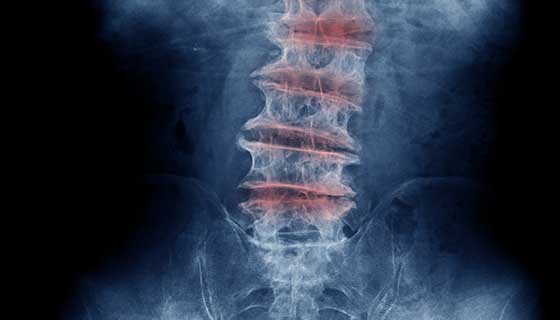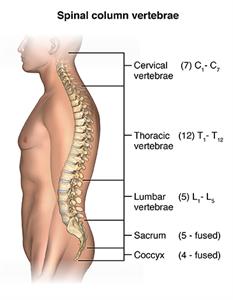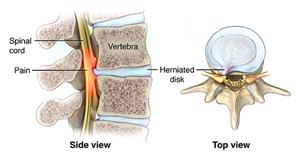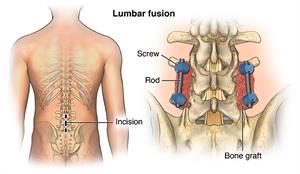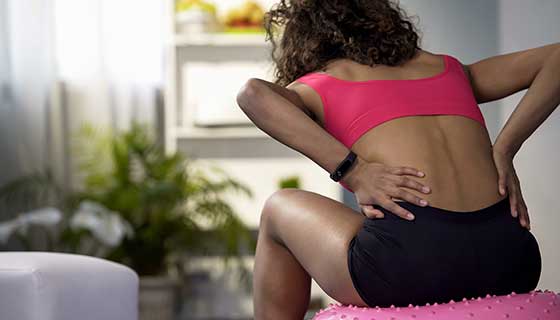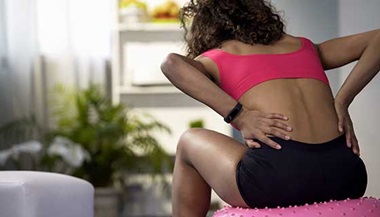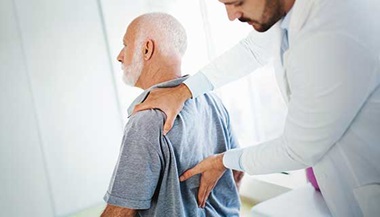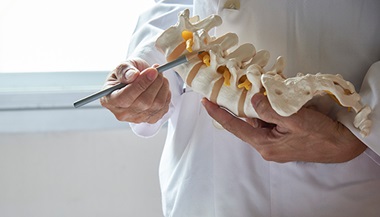Lumbar Spinal Stenosis
What is lumbar spinal stenosis?
Your spinal cord is a bundle of nerves that runs through a tunnel formed by your vertebrae. The tunnel is called the spinal canal . Lumbar spinal stenosis is a narrowing of the spinal canal in the lower part of your back. Stenosis can cause pressure on your spinal cord or the nerves that go from your spinal cord to your muscles.
Spinal stenosis can happen in any part of your spine but is most common in the lower back. This part of your spine is called your lumbar area . Five lumbar vertebrae connect your upper spine to your pelvis.
If you have lumbar spinal stenosis, you may have trouble walking distances or find that you need to lean forward to ease pressure on your lower back. You may also have pain or numbness in your legs. In more severe cases, you may have trouble controlling your bowel and bladder. There is no cure for lumbar spinal stenosis, but you have many treatment choices.
What causes lumbar spinal stenosis?
The most common cause of spinal stenosis is osteoarthritis. This is the gradual wear and tear that happens to your joints over time. Spinal stenosis is common because osteoarthritis begins to cause changes in most people’s spine by age 50. That's why most people who develop symptoms of spinal stenosis are 50 or older. Some people are also born with a spinal canal that may be narrower than other people's.
Besides osteoarthritis, other conditions or things can cause spinal stenosis:
-
Narrow spinal canal
-
Injury to the spine
-
Spinal tumor
-
Certain bone diseases
-
Past surgery of the spine
-
Rheumatoid arthritis
-
Herniated disk
What are the symptoms of lumbar spinal stenosis?
Early lumbar spinal stenosis may have no symptoms. In most people, symptoms develop slowly over time. Symptoms may include:
-
Back pain
-
Burning pain going into the buttocks and down into the legs (sciatica)
-
Numbness, tingling, cramping, or weakness in the legs
-
Loss of sensation in the feet
-
A weakness in a foot that causes the foot to slap down when walking. This is also called foot drop.
-
Loss of sexual ability
Pressure on nerves in the lumbar region can also cause more serious symptoms known as cauda equina syndrome. If you have any of these symptoms, you need to get medical care right away:
-
Loss of bowel or bladder control
-
Severe or increasing numbness between your legs, inner thighs, and back of the legs
-
Severe pain and weakness that spreads into one or both legs. This makes it hard to walk or get out of a chair.
How is lumbar spinal stenosis diagnosed?
To diagnose lumbar spinal stenosis, your healthcare provider will ask you questions about your symptoms and do a complete physical exam. During the physical exam, your provider will look for signs of spinal stenosis. These include loss of sensation, weakness, and abnormal reflexes.
These tests help make a diagnosis:
-
X-rays of your lumbar spine. These may show bone growths called spurs that push on spinal nerves, a narrowing of the spinal canal, or both.
-
Imaging tests. A CT scan or MRI scan can give a more detailed look at the spinal canal and nerve structures.
-
Other studies. You may need a bone scan, a CT taken after injecting dye into the spinal canal (myelogram), nerve conduction studies, and electromyography, an electrical test of muscle activity.
How is lumbar spinal stenosis treated?
If you have lumbar spinal stenosis, many types of healthcare professionals can help you, such as arthritis specialists, nerve specialists, surgeons, and physical therapists. Treatment can include physical therapy, medicine, and sometimes surgery. Except in emergencies, such as cauda equina syndrome, surgery is often the last resort.
-
Physical therapy may include exercises to strengthen your back, stomach, and leg muscles. Learning how to do activities safely, using braces to support your back, stretching, and massage may also be helpful.
-
Medicines may include nonsteroidal anti-inflammatory drugs that relieve pain and swelling, and steroid injections that reduce swelling. Medicines that treat nerve pain or muscle spasm may also be helpful.
-
Surgery includes removing bone spurs and widening the space between vertebrae (laminectomy). The lower back may also be stabilized by fusing together some of the vertebrae. In some cases, fusion is used along with decompression. Decompression is easing the pressure on the nerves.
-
Acupuncture and chiropractic care may also be helpful for some people.
What can I do to prevent lumbar spinal stenosis?
Because almost everyone has some osteoarthritis of the spine by age 50, you can’t really prevent lumbar spinal stenosis. But you may be able to lower your risk. Here are some ways to keep your spine healthy:
-
Get regular exercise. Exercise strengthens the muscles that support your lower back and helps keep your spine flexible. Aerobic exercises, such as walking, swimming, cycling, and weight training, are all good for your back.
-
Maintain good posture. Learn how to safely lift heavy objects. Also, sleep on a firm mattress and sit in a chair that supports the natural curves of your back.
-
Maintain a healthy weight. Extra weight puts more stress on your back and can contribute to developing symptoms of lumbar spinal stenosis.
-
Stop smoking. Smoking accelerates disk degeneration. If you smoke, you should quit.
Living with lumbar spinal stenosis
The best way to manage this condition is to learn as much as you can about your disease, work closely with your healthcare team, and take an active role in your treatment.
Keep your lower back as healthy as possible by maintaining a healthy weight, practicing good body mechanics, and getting regular exercise. Physical therapy may help strengthen back muscles, increase mobility, and reduce pain.
Simple home remedies, such as an ice pack, heating pad, massage, or a long, hot shower, can help. The nutritional supplements glucosamine and chondroitin have been recommended as nutritional supplements for osteoarthritis, but recent studies have been disappointing. Ask your healthcare provider if you should try any nutritional supplements and discuss any alternative treatments or medicines you’re thinking about trying.
When should I call my healthcare provider?
Lumbar spinal stenosis can cause cauda equina syndrome, which needs medical attention right away. Call your healthcare provider if you have:
-
Loss of bowel or bladder control
-
Severe or increasing numbness between your legs, inner thighs, or back of your legs
-
Severe pain and weakness that spreads into one or both legs, making it hard to walk or get out of a chair
Key points about lumbar spinal stenosis
-
Lumbar spinal stenosis is the narrowing of the spine that happens slowly over time.
-
Most people who develop symptoms are age 50 or older. Some people are also born with a spinal canal that may be narrower than other people's.
-
Symptoms can include back pain, burning pain in the buttocks and down the leg, loss of feeling in the feet, and a numbness, cramping, or weakness in the legs.
-
There is no cure for lumbar spinal stenosis, but your healthcare provider can help you manage the condition.
-
Treatment can include physical therapy, medicine, and sometimes surgery.
Next steps
Tips to help you get the most from a visit to your healthcare provider:
-
Know the reason for your visit and what you want to happen.
-
Before your visit, write down questions you want answered.
-
Bring someone with you to help you ask questions and remember what your provider tells you.
-
At the visit, write down the name of a new diagnosis, and any new medicines, treatments, or tests. Also write down any new directions your provider gives you.
-
Know why a new medicine or treatment is prescribed, and how it will help you. Also know what the side effects are.
-
Ask if your condition can be treated in other ways.
-
Know why a test or procedure is recommended and what the results could mean.
-
Know what to expect if you do not take the medicine or have the test or procedure.
-
If you have a follow-up appointment, write down the date, time, and purpose for that visit.
-
Know how you can contact your healthcare provider if you have questions, especially after office hours or on weekends.

